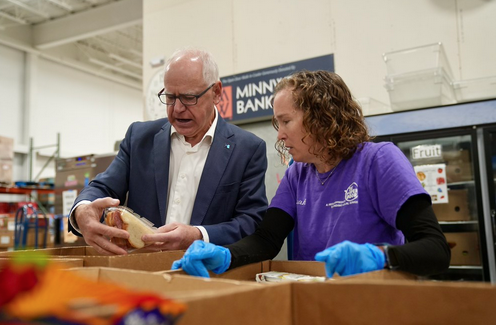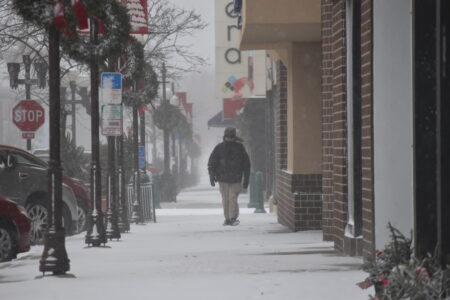Governor announces $4M in new funding for food shelves

Walz food bank After announcing $4 million in emergency funding to Minnesota food shelves, Gov. Tim Walz at Open Door Pantry in Eagan, Walz volunteered to sort donations with volunteer with Leah Raiche. Photo courtesy of office of Gov. Tim Walz
ST. PAUL – Monday, Gov. Tim Walz announced $4 million in emergency one-time funding for Minnesota food shelves.
As the federal government shutdown threatens to continue into November, funding for the Supplemental Nutrition Assistance Program (SNAP) and Minnesota Family Investment Program (MFIP) could be at risk. In Minnesota, approximately 440,000 individuals access SNAP and MFIP benefits, with 36% being children and 18% being seniors. In Brown County, there are currently 788 clients on SNAP.
If SNAP funding is cut in November, emergency food shelves are likely to see an increase in the number of clients they serve. The $4 million in aid will help serve as a stopgap for communities until the federal government reopens.
“It is not a privilege to have food — it is a human right,” Gov. Walz said following the announcement of the food shelf grants. “In the most abundant food supply of any country on Earth, it’s absolutely unnecessary for people to go hungry.”
The $4 million will come from Minnesota’s contingency account and will be distributed by The Food Group to roughly 300 food shelves in the state.
Minnesota Department of Children, Youth, and Families commissioner Tikki Brown said each food shelf will receive $5,000 with additional funding based on local need.
Brad Kirk, executive director of the New Ulm Area Emergency Food Shelf, said he has not yet heard from The Food Group about how much they will receive, but expects a minimum of $5,000. He plans to spend the funds to purchase food from local sources.
“The SNAP cuts will impact the stores where people typically spend benefits,” Kirk said.
The New Ulm Food Shelf provides an average of 160 families per month. Each family may visit the food shelf once a month. Each visit, they received three days’ worth of food.
Kirk said he was certain the number of clients was going to increase if SNAP were cut. He said there are already people on SNAP using the food shelf. Without it the need will increase.
“The food shelf is not here to replace SNAP,” Kirk said. “But we will fill in the gaps short-term based on clients’ needs.”
The Springfield Food Shelf is also preparing for increased usage if SNAP funding is cut. Shari Koll, the director of the Springfield Food Shelf, said they currently serve 140-150 households a month, but this will likely increase with SNAP benefits cuts.
“There were people coming who were already on SNAP,” Koll said. “Food shelves were never intended to be the sole source of food products. We just fill in by giving families four or five days’ worth of food to help in the short-term.”
She said the Springfield Food Shelf does see clients from Sleepy Eye and New Ulm already. If an extra 100 clients are added in the month, they likely won’t be able to provide as much food to each family.
Koll said she worries about the impact this will have on the mental health of clients.
“Many of the people coming in are concerned where they are going to get food for their families,” she said.
Koll said she has not heard if and when the Springfield Food Shelf will receive emergency funds, but said the funding would help greatly, especially with purchasing commodity items like meat.
“I am not worried about running out of food,” Koll said. “I am concerned about delivery trucks suddenly stopping.”
She said if the federal shutdown continues, some of the food trucks might not be able to deliver to rural Minnesota locations. In that case, Springfield Food Shelf might need to rely on local drivers or community donations. However, she was optimistic that the Springfield community volunteers would step up in an emergency.




